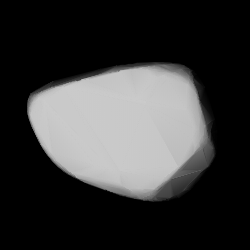La Paz, provisional designation 1923 PD, is a carbonaceous asteroid from the outer region of the asteroid belt, approximately 40 kilometers in diameter. It was discovered on 31 October 1923, by German astronomer Max Wolf at the Heidelberg-Königstuhl State Observatory and named after the city La Paz in Bolivia.
1015 Christa, provisional designation 1924 QF, is a dark background asteroid from the outermost regions of the asteroid belt, approximately 96 kilometers in diameter. It was discovered on 31 January 1924, by German astronomer Karl Reinmuth at the Heidelberg-Königstuhl State Observatory in southwest Germany. The meaning of this asteroids's name is unknown.
1031 Arctica, provisional designation 1924 RR, is a dark asteroid from the outer region of the asteroid belt, approximately 75 kilometers in diameter. It was discovered on 6 June 1924, by Soviet−Russian astronomer Sergey Belyavsky at Simeiz Observatory on the Crimean peninsula. It was named for the Arctic Sea.
1057 Wanda, provisional designation 1925 QB, is a carbonaceous background asteroid from the outer region of the asteroid belt, approximately 43 kilometers in diameter. It was discovered by Grigory Shajn at the Simeiz Observatory in 1925, and later named after Polish–Soviet writer Wanda Wasilewska. The asteroid has a rotation period of 28.8 hours.
1124 Stroobantia, provisional designation 1928 TB, is a metallic asteroid from the outer region of the asteroid belt, approximately 25 kilometers in diameter. It was discovered on 6 October 1928, by Belgian astronomer Eugène Delporte at Uccle Observatory in Belgium. It is named for astronomer Paul Stroobant.
1154 Astronomia, provisional designation 1927 CB, is a carbonaceous background asteroid from the outer regions of the asteroid belt, approximately 60 kilometers in diameter. It was discovered by German astronomer Karl Reinmuth at the Heidelberg-Königstuhl State Observatory on 8 February 1927. The asteroid was named for the natural science of astronomy.
1712 Angola, provisional designation 1935 KC, is a dark asteroid from the outer regions of the asteroid belt, approximately 66 kilometers in diameter. It was discovered on 28 May 1935, by English-born South African astronomer Cyril Jackson at Johannesburg Observatory in South Africa. It is named after the Republic of Angola.
1815 Beethoven, provisional designation 1932 CE1, is a carbonaceous background asteroid from the outer regions of the asteroid belt, approximately 30 kilometers (19 miles) in diameter. It was discovered on 27 January 1932, by German astronomer Karl Reinmuth at the Heidelberg Observatory. The uncommon F-type asteroid seems to have a long rotation period of 54 hours (tentative). It was named after Ludwig van Beethoven.
1295 Deflotte, provisional designation 1933 WD, is a carbonaceous asteroid from the outer regions of the asteroid belt, approximately 48 kilometers in diameter. It was discovered on 25 November 1933, by French astronomer Louis Boyer at the Algiers Observatory in Algeria, North Africa. The asteroid was named after the discoverer's nephew.
3642 Frieden, provisional designation 1953 XL1, is a carbonaceous asteroid from the middle region of the asteroid belt, approximately 35 kilometers in diameter. It was discovered by German astronomer Herta Gessner at Sonneberg Observatory on 4 December 1953. It is named after the goddess of peace, Pax.
1267 Geertruida, provisional designation 1930 HD, is a carbonaceous background asteroid from the inner regions of the asteroid belt, approximately 20 kilometers in diameter. Discovered by astronomer Hendrik van Gent at Johannesburg Observatory in 1930, the asteroid was later named after Geertruid Pels, sister of Dutch astronomer Gerrit Pels.

1687 Glarona is a stony Themis asteroid approximately 34 kilometers in diameter from the outer region of the asteroid belt. It was discovered by Swiss astronomer Paul Wild at Zimmerwald Observatory near Bern, Switzerland, on 19 September 1965. It was later named after the Swiss Canton of Glarus.

1693 Hertzsprung is a dark and elongated background asteroid from the middle region of the asteroid belt, approximately 39 kilometers in diameter. It was discovered on 5 May 1935, by Dutch astronomer Hendrik van Gent at the Leiden Southern Station, annex to the Johannesburg Observatory in South Africa.
2140 Kemerovo, provisional designation 1970 PE, is a dark asteroid from the outer region of the asteroid belt, approximately 30 kilometers in diameter.
1264 Letaba, provisional designation 1933 HG, is a carbonaceous asteroid and possible tumbler from the background population of the outer asteroid belt, approximately 70 kilometers in diameter. It was discovered on 21 April 1933, by South African astronomer Cyril Jackson at the Union Observatory in Johannesburg. The asteroid was named for the Letaba River in eastern South Africa.
1605 Milankovitch, provisional designation 1936 GA, is an Eoan asteroid from the outer region of the asteroid belt, approximately 31 kilometers in diameter. It was named after Serbian scientist Milutin Milanković.
1330 Spiridonia, provisional designation 1925 DB, is a dark background asteroid of primitive composition, located in the outer regions of the asteroid belt, approximately 65 kilometers in diameter. It was discovered on 17 February 1925, by Soviet astronomer Vladimir Albitsky at the Simeiz Observatory on the Crimean peninsula. The asteroid was named after the discoverer's brother-in-law, Spiridon Zaslavskij.

1336 Zeelandia, provisional designation 1934 RW, is a stony Koronian asteroid from the outer regions of the asteroid belt, approximately 21 kilometers in diameter. It was discovered on 9 September 1934, by Dutch astronomer Hendrik van Gent at the Union Observatory in Johannesburg, South Africa. The asteroid was named for the Dutch province of Zeeland.
1296 Andrée, provisional designation 1933 WE, is a stony Nysian asteroid from the inner regions of the asteroid belt, approximately 25 kilometers in diameter. It was discovered on 25 November 1933, by French astronomer Louis Boyer at the North African Algiers Observatory, Algeria, and named after the discoverer's niece.
1461 Jean-Jacques, provisional designation 1937 YL, is a metallic asteroid from the outer region of the asteroid belt, approximately 34 kilometers in diameter. It was discovered on 30 December 1937, by French astronomer Marguerite Laugier at Nice Observatory in southern France, who named it after her son Jean-Jacques Laugier.



